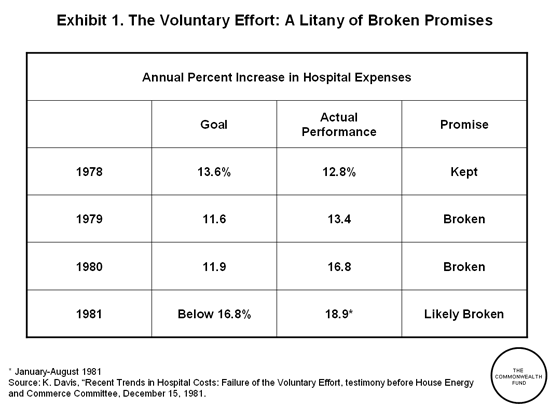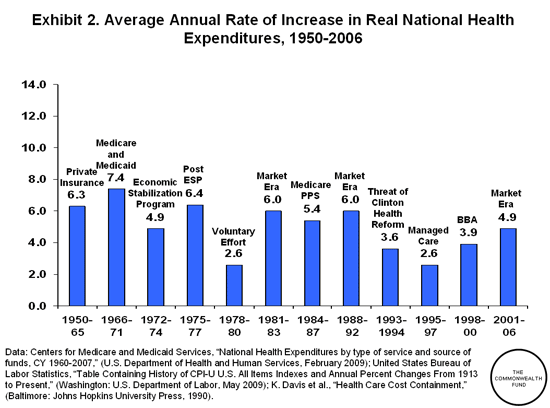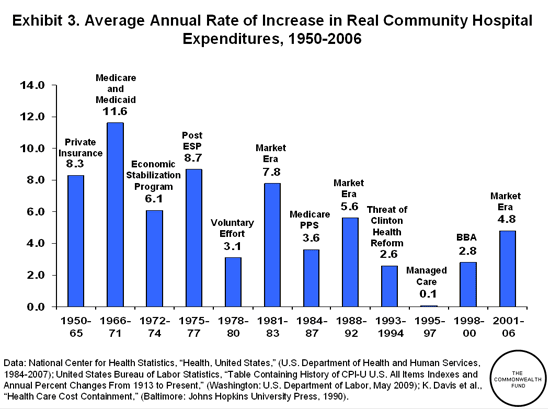By Karen Davis
In a May 11 letter to President Obama, the leaders of six health care organizations—the Advanced Medical Technology Association, the American Medical Association, America's Health Insurance Plans, Pharmaceutical Research and Manufacturers of America, American Hospital Association, and Service Employees International Union—expressed their support for health reform, writing: "We will do our part to achieve your Administration's goal of decreasing by 1.5 percentage points the annual health care spending growth rate—saving $2 trillion or more."
The organizations went on to say that they are developing consensus proposals on administrative simplification, standardization, and transparency; reducing overuse and underuse; encouraging coordinated care and adherence to evidence-based best practices and therapies; improvements in care delivery models, health information technology, workforce deployment and development; and regulatory reforms. The organizations also indicated that they support health promotion and disease prevention, including obesity prevention.
In response, a White House Fact Sheet stated that health care industry leaders "are proposing to take aggressive steps to cut health care costs that, if done in the context of comprehensive health reform, will reduce the annual health care spending growth rate by 1.5 percentage points for the next 10 years.” By the end of the week, the industry coalition clarified that they did not commit to a specific and immediate year-by-year target, though their statement did not retract their promise of $2 trillion in savings over 10 years.
This back-and-forth between the government and industry signals the difficulty of developing, enacting, and implementing effective measures to bend the health care cost curve. What should be clear, however, is that a strictly voluntary effort to slow the growth in costs is unlikely to be successful, and that health reform will need to incorporate legislative provisions and enforcement mechanisms to ensure that spending targets are met. The Medicare Trustees' recent report that the Hospital Insurance Trust Fund will be exhausted in 2017 underscores the need to take effective action.
As we prepare health reform legislation, the history of failed voluntary health care efforts in other periods of crisis is instructive. President Nixon imposed wage and price controls on the nation’s economy in the wake of inflation triggered by the Vietnam War. Congressional legislative efforts to retain these controls in the health sector after the Executive Order expired were defeated when industry leaders pledged to control costs voluntarily. Similarly, President Carter’s proposed hospital cost-containment legislation was defeated with a promise from industry leaders that a "Voluntary Effort" would be sufficient to stem inflationary increases in hospital spending. An in-depth look at those prior efforts yields important lessons for the challenges ahead.
Voluntary Efforts: A Dismal History
From 1968 through 1970, when the overall inflation in the economy was 5.2 percent, Medicare hospital expenditures increased at an annualized rate of 18.1 percent, making health care costs an issue of intense concern. In 1971, President Nixon put a wage and price freeze on the entire economy, including the health sector, by Executive Order. Later that year, the freeze was replaced by an initiative with specific inflation targets for each sector of the economy. By the following year, a ceiling of 5.5 percent on health care wage increases, 2.5 percent for non-labor costs, and 1.7 percent for new technology and services was imposed.
When the Executive Order expired in 1974, Congress sought to continue the health care cost controls legislatively. The hospital industry strenuously opposed legislation and promised to control costs voluntarily. However, once the Economic Stabilization Program controls on the health sector were lifted, health expenditures increased rapidly.
When President Carter assumed office in January 1977, hospital expenses were increasing annually 8.7 percent faster than the overall inflation rate, posing a serious obstacle to his plans to balance the federal budget and expand health insurance coverage to the entire population. In February, Carter announced his intention to submit a major legislative proposal constraining the rate of increase in hospital costs, and as a new appointee at the Department of Health, Education, and Welfare, I was charged with developing the proposal. In April 1977, we submitted to Congress a plan to limit the rate of increase in hospital revenues for all patients to 3 percentage points over the overall inflation rate.
The major argument launched by the industry was that they could voluntarily contain costs without federal legislation. After extensive debate and Committee action, a bill passed the Senate in late 1978 that provided for a period of voluntary restraints on hospital cost growth, and a trigger initiating mandatory controls if the voluntary effort failed, but the session ended without action on the House floor. In 1979 at the behest of congressional leaders, the Carter administration introduced a new hospital cost-containment bill that contained a voluntary trigger, specifying that mandatory limits would only be imposed if national, state, and individual hospital voluntary limits were not met, with limits set comparable to industry voluntary goals. The bill passed three major committees, but was defeated on the House floor in November 1979.
It was the launch of a formal Voluntary Effort created by a coalition of health care provider organizations (most notably the American Hospital Association, the Federation of American Hospitals, the American Medical Association, and Blue Cross/Blue Shield) that nailed the lid on the legislative coffin. The coalition set a 1978 goal of reducing the rate of increase by 2 percentage points below the 1977 rate of increase; that goal of 13.6 percent increase in 1978 was met. All subsequent goals, as well as goals related to holding down increases in the number of beds and employees, as well as increases in capital investment were substantially exceeded, leading to the end of the effort in 1981 and congressional hearings at which I testified that led to a new system of Medicare hospital payment.

The failure of the Voluntary Effort set the stage for enactment of the 1982 Tax Equity and Fiscal Responsibility Act (TEFRA) that established a limit on the rate of increase in Medicare hospital payment rates based on a hospital market basket price index, plus 1 percent for new technology and services. The TEFRA legislation in turn paved the way for enactment of the Medicare hospital prospective payment system based on Diagnosis Related Groups (DRGs). Beginning in October 1, 1983, hospitals were paid a prospectively determined payment rate for each hospital patient, rather than its own costs. Payment rates were to increase each year at the rate of increase in the hospital market basket price index plus 1 percentage point. The legislation created the Prospective Payment Assessment Commission (now called the Medicare Payment Advisory Commission) to oversee the system and make recommendations to Congress. During periods when Congress has acted to limit increases in hospital payment rates, Medicare spending has slowed relative to private sector spending.
Lessons from Past Efforts to Control Costs
This history is pertinent to today’s health reform consideration. Industry leaders' response to federal consideration of mandatory controls has consistently been to promise voluntary efforts. Yet without an enforcement mechanism those promises have quickly evaporated as each individual provider independently pursues its own interests. But controls – whether crude controls like the Nixon wage and price controls and the TEFRA limits on Medicare hospital payment increases or more sophisticated approaches like the Medicare DRG prospective payment legislation--have worked to slow increases.


To ensure the promised savings are realized, policymakers should consider incorporating into health reform expenditure targets that hold increases to 1.5 percentage points below baseline projections. As several analysts have pointed out, reducing the annual growth rate in national health expenditures by 1.5 percent means that the entire health care industry can still expect sustained revenue increases over the coming decade. Moreover, if cost reduction targets are incorporated into larger payment reform efforts that reward quality and value, ample opportunities for revenue growth will exist for efficient and innovative insurers and providers.
A commitment from business and industry to limit the unsustainable increases in health care is important as we work together to build a high-performance health system that works for all Americans. The President and Congress now need to follow up on this pledge with legislation that ensures the promise is kept.
We are interested in your feedback. Please take advantage of our commenting feature by clicking on the "Post a Comment" button.


